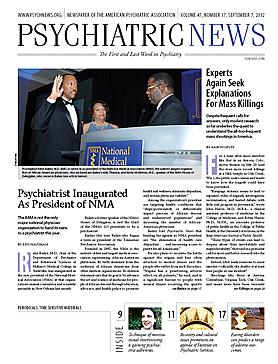Abnormalities in eye movements such as the ability to follow a single spot as it moves from side to side across a screen or the ability to keep one’s eyes locked onto a single point are well established in people with schizophrenia.
European and American scientists measured, in 88 subjects with schizophrenia and in 88 healthy control subjects, not only these two types of eye movements but two others known to be abnormal in people with schizophrenia. They then used the subjects’ eye-movement-performance measures to build a mathematical model to evaluate the four types of eye movements. Finally they tested the model on some of their original subjects and on 36 new patients with schizophrenia and on 52 new healthy control subjects. They found that the model could discriminate the schizophrenia cases from the controls with 98 percent accuracy.
The results were published May 24 in Biological Psychiatry.
Psychiatric News asked the lead scientist—Philip Benson, Ph.D., of the University of Aberdeen in Scotland—why he and his team were able to achieve such a high level of discrimination with their model, while other scientists have failed to do so. “The trick seems to have been to use a combination of tests and a clever method to analyze their measures,” Benson said.
“This is a very interesting study,” L. Elliot Hong, M.D., a professor of psychiatry at the University of Maryland and a schizophrenia expert, commented to Psychiatric News. “It reveals that most schizophrenia patients can be differentiated from healthy controls using such eye-tracking parameters. [However,] as the authors pointed out, the important next steps are testing of specificities, that is, whether these measures are specific only to schizophrenia, or whether they can also separate different psychiatric diagnoses or even different subsyndromes within the schizophrenia diagnosis.”
Benson agreed with Hong on these points. Actually, he said, “We already know that the model can distinguish cases diagnosed with bipolar disorder [from those diagnosed with schizophrenia] with around 95 percent accuracy. We have preliminary data suggesting that major depressive disorder can also be distinguished [from schizophrenia], which is a tremendously exciting finding.”
His team’s findings, Benson said, suggest that mentally healthy individuals and those with schizophrenia, bipolar disorder, or major depressive disorder may have unique eye movements, and if so, this “may mean that we have discovered a biomarker for major neurodevelopmental disorders.”
Benson is optimistic that their model might become clinically available to help diagnose schizophrenia and perhaps other psychiatric disorders. “We are currently undertaking a market survey in the United States, the United Kingdom, and Europe to try to build a picture of how this instrument might be received by health care professionals,” he said. He and his group are also seeking venture capital to turn their model into a clinical reality, he noted.
The study’s funding sources included the Royal Society of London, U.S. National Institute of Mental Health, the Genome-Wide Association Study, and the University of Aberdeen.

